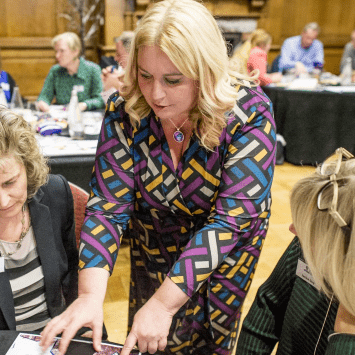Posted in Blog, Design Thinking, Entrepreneurship, Facilitation, Innovation by Jo North
When you have lots of ideas from your brainstorming session, deciding which ones to focus on, or how to prioritize ideas can seem like a Herculean task.
In this article I share my expert guidance and the 8 best innovation frameworks that will give you some great options on how to prioritize ideas effectively.
Innovation Frameworks: Jump To Links
- 1. Idea Sorter
- 2. MoSCoW Method
- 3. The KJ Method (Kawakita Jiro Method)
- 4. RICE Scoring Method
- 5. Kano Model
- 6. WSJF (Weighted Shortest Job First)
- 7. Eisenhower Box (or Urgent-Important Matrix)
- 8. Ivy Lee Method
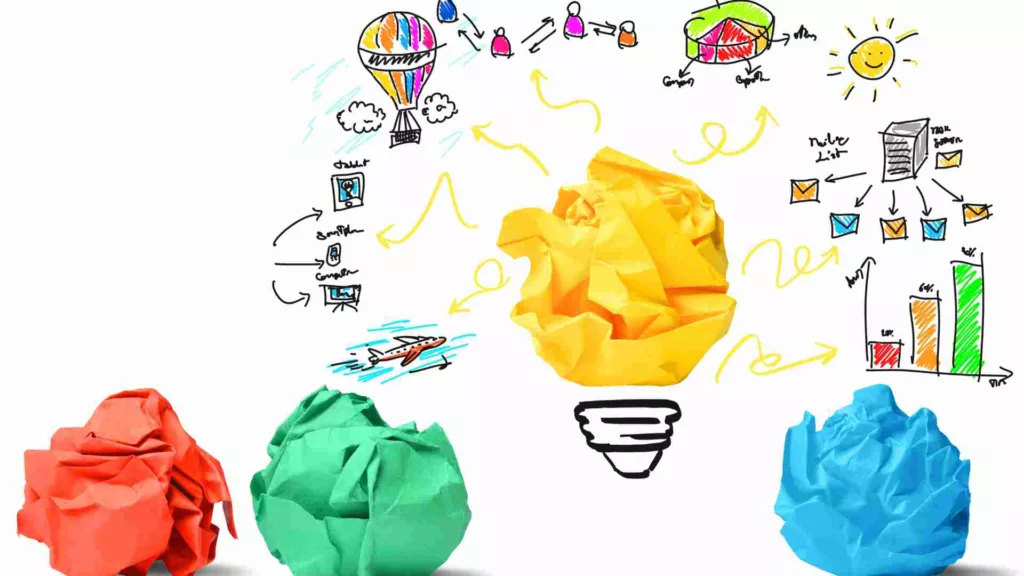
Idea Proliferation
Idea proliferation simply means coming up with lots of ideas. It is a really important ingredient of creativity. As Steve Jobs famously said, “Creativity is just connecting things.” When you’re flooded with ideas, you give yourself numerous dots to connect, leading to the birth of newer and often superior concepts.
Creativity is just connecting things. When you ask creative people how they did something, they feel a little guilty because they didn’t really do it, they just saw something. It seemed obvious to them after a while.
steve jobs
How Idea Proliferation Works
Having lots of ideas helps you to come up with even more ideas! Here’s why:
- If you have 2 ideas – a and b – you can only derive 1 new idea from those which is ab.
- If you have 3 ideas – a, b, and c – you can derive 4 new ideas which are ab, ac, bc, and abc.
- If you have 4 ideas – a, b, c, and d – you can then derive 11 new ideas which are ab, ac, ad, bc, bd, cd, abc, abd, acd, bcd, and abcd.
To give you clearer picture, here are the numbers above and some more:
- 2 ideas can generate 1 new ideas.
- 3 ideas can generate 4 new ideas.
- 4 ideas can generate 11 new ideas.
- 5 ideas can generate 26 new ideas.
- 6 ideas can generate 57 new ideas.
- 7 ideas can generate 120 new ideas
Ideas are Your Competitive Currency
To compete, on an individual, professional level, as a team, and as an organization, your core currency is ideas – ideas on how to solve problems, create opportunities, differentiate, bring new, added value.
Ideally you will create a constant flow of ideas, so that you always stay fresh, in tune with the changing market, and become the architect of your own opportunities.
Navigating the Abundance of Ideas and Strategies to Tackle It
The plethora of ideas you have can be a double-edged sword. On one hand, it’s thrilling to have a mind that’s a hotbed for creativity; on the other, it can be paralyzing, not knowing where to kick off or which idea holds the most promise.
Turning an idea into a tangible innovation or opportunity isn’t just about an ‘aha’ moment. It demands time, monetary investment, resources, and undivided attention. And every moment you spend on one idea, you’re foregoing the opportunity to nurture another. So, how do we discern which idea might be a winner?
It’s crucial to have a structured approach to how to prioritize ideas. Imagine a meticulously designed funnel where each idea is evaluated just enough to gauge its potential. Based on this assessment, you can decide to progress it further, put it on a back burner, or dismiss it altogether.
Capturing Ideas
If you lead a team or business, it’s really helpful to have somewhere to capture all your collective ideas.
If you’re a virtual team, or out and about a lot, and you don’t have anything in place, easy-to-use, low cost apps such as Trello or Slack can be really effective. Sharepoint and GoogleDrive work well too, but my absolute favourite is Milanote.
Milanote is also brilliant for virtual online collaboration, from ideation and vision boards through to vision boards. It’s super intuitive to use and there’s a great free option. I’ve also used a Chrome extension for Milanote that saves me even more time. You can see what you can do in Milanote here in this image below.
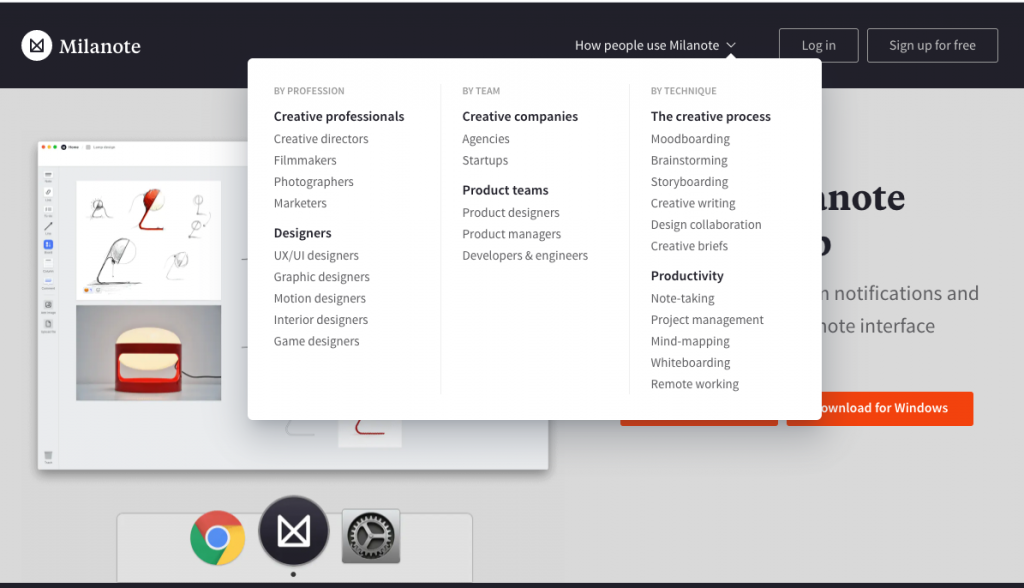
If you share an office you could go old school of course and use a whiteboard, although I’d avoid the suggestion box idea, as research shows it’s healthier to create a culture of openness and discussion when it comes to innovation.
Idea Evaluation and Shortlisting
When you have a large number of new ideas, I really do not recommend that you spend a long time doing detailed evaluation of each one. This is a waste of time, and could take a long time to complete. Instead, it’s better to use your intuition, along with the right amount of structure, to do a first cut. Then focus your subsequent efforts on those ideas that make it through.
Here are some great innovation frameworks that you can choose from to prioritize ideas. Each of these tools and frameworks has its own advantages and is suited for different contexts, team sizes, and types of projects. The key is to pick one that aligns best with your goals, team, and type of ideas you are dealing with.
1. Idea Sorter
Use my Idea Sorter to create a useful, prioritized runway for your ideas quickly and effectively.
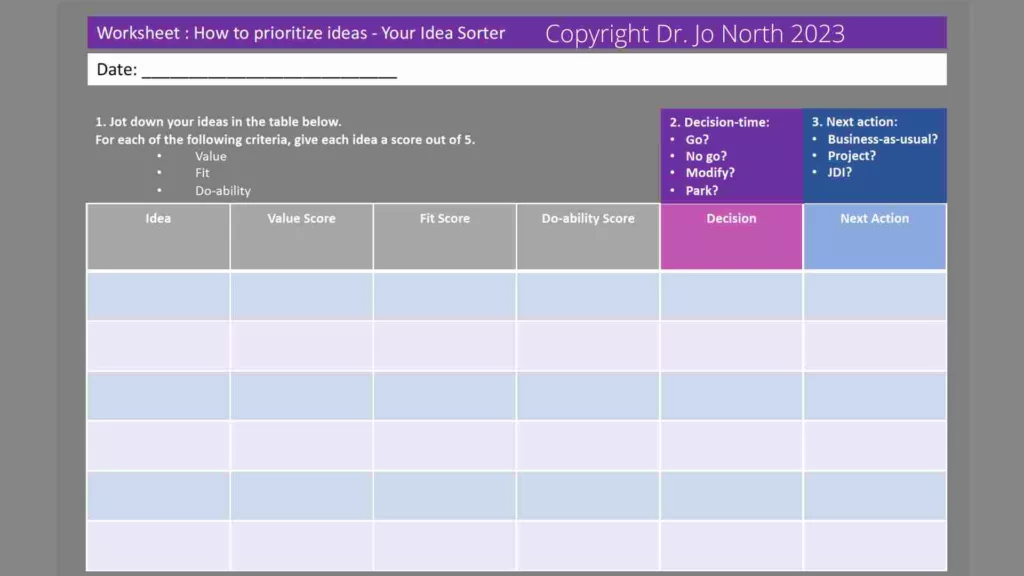
Use Criteria and Structure
The criteria to apply in your first, high level screening process include:
- Value – the tangible and intangible benefits that the idea could bring.
- Fit – how well the idea fits into your overall strategy and portfolio.
- Do-ability – how achievable the idea is, given the resources that you believe you can access, including with some stretch.
Give a score for each idea’s value, fit and do-ability.
Make Decisions
Then, as you sift your ideas through these criteria, you can make a decision on each idea:
- Go – the idea meets all the criteria, and should progress to the next stage.
- No go – the idea falls significantly short of the criteria.
- Modify – the idea nearly meets all the criteria, and could meet them all with some tweaks.
- Park – the idea is showing potential merit but the timing or conditions aren’t right. Hold this as a potential idea to revisit in the future.
Applying this structure and criteria to sort your ideas helps you to view them as part of a portfolio. You’ll make better decisions on how to allocate your finite time and resources.
Agree the Next Action
When you have your ‘Go’ ideas, the next stage is to action them appropriately. Put each idea into the most appropriate category:
- Business-as-usual (BAU) – work it into the usual operations of the relevant part of your business activities.
- JDI – ‘Just do it!’ – crack on straightaway!
- Project – needs organization, structure and planning above the day-job or ordinary business activities, and is best delivered as a special project in itself.
2. The MoSCoW Method
The MoSCoW Method prioritization technique helps you to categorize your ideas into four categories:
- Must have: Critical for the project’s success.
- Should have: Important but not crucial.
- Could have: Nice to have if it’s possible within the project’s constraints.
- Won’t have (this time): Ideas that are recognized but deferred for the future.

When to Consider Using the MoSCoW Method
The MoSCoW method offers a straightforward prioritization technique that helps in distinguishing the importance and urgency of different requirements. Innovators and product managers might use the MoSCoW method in the following scenarios:
- Project Scope Definition: At the onset of a project, when defining its scope, the MoSCoW method assists in identifying which features or tasks are essential for the project’s core objectives and which can be set aside for later phases or versions.
- Resource Allocation: When resources, be it time, budget, or manpower, are limited, the MoSCoW method can help determine where to allocate resources most effectively.
- Stakeholder Communication: When communicating with stakeholders, especially non-technical ones, the MoSCoW method provides a simple language to set expectations and ensure everyone understands the project’s priorities.
- Agile Development: In agile frameworks, where iterations and feedback loops are frequent, the MoSCoW method aids in determining which features to develop in the upcoming sprint or iteration.
- Product Backlog Management: For product managers, when managing a backlog filled with features, enhancements, and bug fixes, the MoSCoW method helps in categorizing and prioritizing these items.
- Feature Prioritization: When there’s a plethora of potential features to include in a product or update, this method helps product managers decide which features are a must-have for the release versus those that can wait.
- Decision-making Amid Uncertainty: In situations where there is ambiguity or changing requirements, the MoSCoW method offers a flexible framework to reassess and reprioritize quickly.
- Time-sensitive Projects: For projects with a tight deadline or fixed release date, the method assists in ensuring that the most critical features are developed and delivered on time.
- Collaborative Environments: In situations where a team comprises individuals from diverse departments or stakeholders with varied interests, the MoSCoW method can be a consensus-building tool.
Use MoSCoW as a Dynamic Tool
While the MoSCoW method is versatile and can be applied in various scenarios, it’s crucial to remember that it’s a dynamic tool. As feedback is received, market conditions change, or new insights are gained, priorities might shift. Regularly revisiting and adjusting priorities using the method ensures that projects remain aligned with the desired outcomes.
3. The KJ Method (Kawakita Jiro Method)
The KJ Method, named after its creator Kawakita Jiro, is a consensus-building tool designed to help groups transition from individual ideas to collective insights. It’s particularly useful for organizing large volumes of data or ideas into themed clusters for easier analysis and decision-making.
Steps to Use the KJ Method
Once you have generated all your ideas, follow these steps:
- Display Ideas: Stick all notes on a wall or board where everyone can see. Random placement is fine at this stage.
- Group Similar Ideas: As a team, start organizing the notes into related clusters. Don’t discuss or debate yet; just let patterns emerge. Similar ideas or themes should be placed near each other.
- Name Each Group: Once you have your clusters, collaboratively come up with a short title or theme for each group. This helps encapsulate the core insight of each cluster.
- Prioritize and Discuss: Now, reflect on the groups you’ve formed. Discuss the insights, patterns, or surprises you see. Prioritize clusters based on importance, feasibility, or other criteria relevant to your initial question.
- Document and Take Action: Capture the grouped ideas and their themes. Use this structured output to drive action plans, strategies, or further analysis.

Tips for First-Time Users
- Stay Silent Initially: When first grouping ideas, try to limit discussion. This prevents dominant voices from overshadowing others and lets the patterns emerge naturally.
- Be Open-minded: Allow the process to flow without too much judgment. The goal is to see collective insights, even if they differ from your initial thoughts.
- Work Physically: While virtual tools can replicate the KJ Method, it’s traditionally and often most effectively done using physical sticky notes and a large wall or board.
The KJ Method offers a structured yet organic way to consolidate a group’s collective knowledge and insights on a particular topic. By letting patterns and themes emerge, you gain clarity and consensus, making it easier to decide on next steps.
4. RICE Scoring
The RICE Scoring Method is a systematic approach to evaluate and rank potential project tasks or ideas. It’s an acronym that stands for Reach, Impact, Confidence, and Effort. If you’re looking for a structured way on how to prioritize ideas, RICE is an excellent place to start.
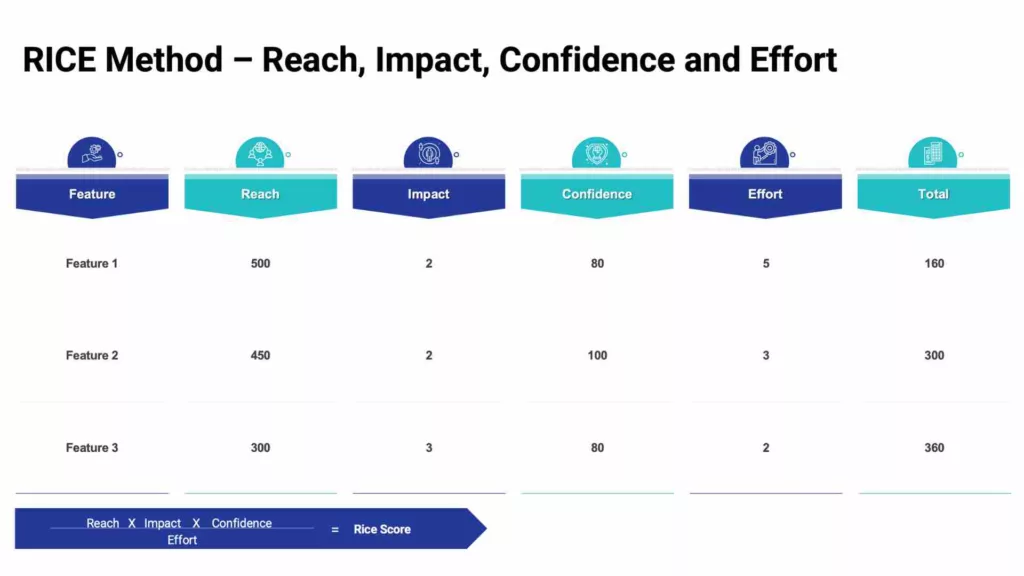
Steps to Implement RICE Scoring
- Define Your Ideas: Before starting with RICE, list down all the ideas or features you’re considering.
- Reach: Estimate how many people each idea will affect within a given period (e.g., a quarter or a year). This could be users, customers, or any other relevant metric for your project.
- Impact: Assess the potential impact on an individual once the idea is executed:
- 3 = Massive impact
- 2 = High impact
- 1 = Medium impact
- 0.5 = Low impact
- Confidence: Quantify your confidence in both the Reach and Impact estimates:
- 100% = Highly confident
- 80% = Pretty confident
- 50% = Making a somewhat educated guess
- Effort: Determine the amount of effort required to implement the idea. This is usually measured in person-months or another metric that suits your team’s working style.
- Calculate the RICE Score: For each idea, use the formula: RICEScore=(ReachxImpactxConfidence)/Effort
- Rank and Prioritize: Once you have the RICE score for each idea, rank them. The higher the score, the higher the priority.
Advantages of RICE Scoring
- Provides a quantitative method for ranking ideas, making decisions more objective.
- Encourages teams to consider both the potential benefits and costs associated with each idea.
- Offers a structured way to engage stakeholders in discussions about priority.
The RICE Scoring Method offers a systematic and transparent approach to this end, ensuring your team is working on the most impactful tasks at any given time.
5. The Kano Model
In product development and innovation, understanding customer needs and desires is paramount. One tool that has proven exceptionally valuable for this purpose is the Kano Model.
What is the Kano Model?
Developed in the 1980s by Professor Noriaki Kano, this model is a theory for product development and customer satisfaction. It categorizes customer preferences into different levels and suggests that by meeting specific types of needs, companies can better satisfy and, even better, delight their customers.
This tool is a good one to use when your thinking and ideas are more developed or advanced.
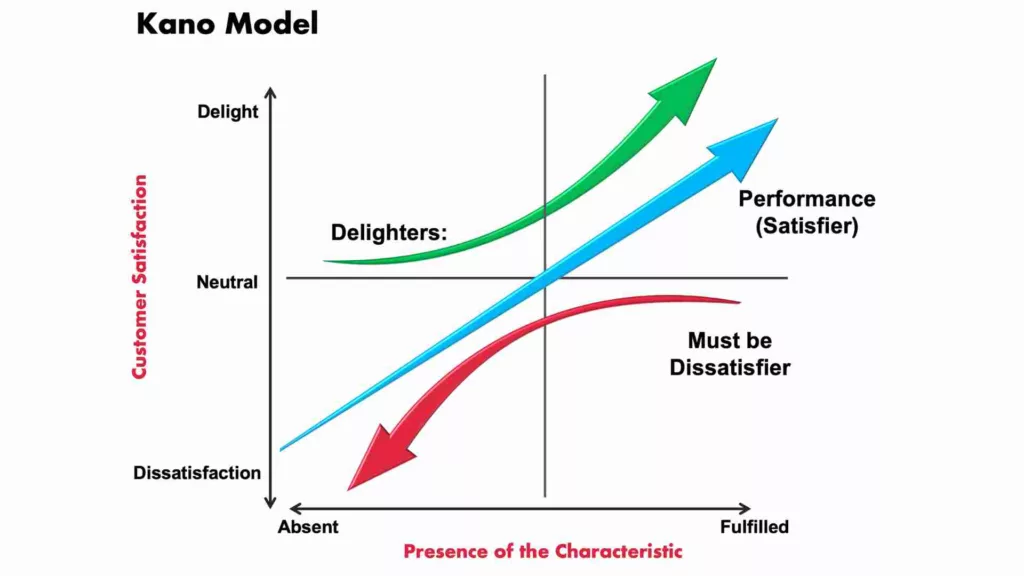
The Five Categories of the Kano Model
The model is made up of five key categories. These are:
- Basic Needs: These are the essential features or attributes that customers expect. Failing to meet these needs results in dissatisfaction, while meeting them doesn’t necessarily lead to satisfaction—it’s merely the price of entry.
- Performance Needs: These are the expressed needs of the customer. Improving these features will increase customer satisfaction and vice versa. Think of them as the features customers would list if asked what they wanted.
- Excitement Needs: Unexpected features or attributes that, when present, can significantly increase satisfaction, but when absent, don’t cause dissatisfaction. They have the power to delight and differentiate products from competitors.
- Indifferent Needs: Features or attributes towards which customers are indifferent. Their presence or absence doesn’t significantly impact satisfaction.
- Reverse Needs: These are unique; for some customers, the presence of these features is satisfying, while for others, the same feature can be dissatisfying. Understanding your target audience is crucial for these needs.
How to Prioritize Ideas Using the Kano Model:
- Gather Customer Feedback: Start by surveying your customers or potential customers. Ask them about features, attributes, or ideas you have or are considering implementing.
- Categorize Feedback: Using the responses, categorize the needs into the five Kano categories. This will give you an understanding of what your customers expect, desire, or would be delighted by.
- Prioritize Basics: Ensure you’ve covered all the basic needs first. These are non-negotiable and form the foundation of your product or service.
- Balance Performance: Once basic needs are met, look at performance needs. These will be the primary drivers of satisfaction and will often form the bulk of your development efforts.
- Sprinkle in Excitement: Once you have a solid product or service that meets basic and performance needs, look for ways to delight your customers with excitement needs. These can be game-changers in competitive markets.
- Reevaluate Periodically: Customer needs and desires evolve. Regularly gather feedback and reassess your priorities based on the Kano Model.
Benefits of Using the Kano Model
There are some great benefits from using the Kano Model. These include:
- Informed Decisions: It provides a clear framework for understanding where to allocate resources.
- Customer-Centric Approach: Puts the customer at the heart of product development, leading to better market fit.
- Competitive Advantage: By addressing excitement needs, companies can set themselves apart from the competition.
When considering how to prioritize ideas, the Kano Model stands out as an invaluable tool. It provides a structured, customer-centric approach to innovation and product development. By understanding and meeting the varying needs of customers, you can use it to help create products and services that not only satisfy but also delight.
6. WSJF (Weighted Shortest Job First)
Used in the SAFe (Scaled Agile Framework), WSJF (Weighted Shortest Job First) prioritizes jobs or ideas based on the cost of delay and job size. It helps in determining which tasks to tackle first based on the value they deliver and the time they take.
Steps to Implement WSJF
- List Features/Jobs: Start by listing all the features or jobs you’re considering.
- Determine Value: For each feature, estimate the perceived value to the business or user if that feature/job is completed.
- Estimate Job Size: Assess the effort required to complete each feature/job. This can be in terms of time, resources, complexity, etc.
- Calculate WSJF Score: For each feature/job, use the formula: WSJFScore=Value/JobSize
- Rank and Execute: Rank features/jobs by their WSJF score. Higher scores are tackled first, as they offer the most value for the least effort.
WSJF helps teams prioritize ideas that deliver the maximum value in the shortest time. It’s all about achieving the biggest bang for your buck (or effort)!
Take a look at the SAFe detailed instructions here for visuals and more information on how to use this framework.
7. Eisenhower Matrix (or Urgent-Important Grid)
The Eisenhower Matrix, often referred to as the Urgent-Important Grid, is an effective tool named after President Dwight D. Eisenhower. It aids in determining which ideas should be pursued immediately, which ones to plan for, delegate, or abandon based on their urgency and significance.
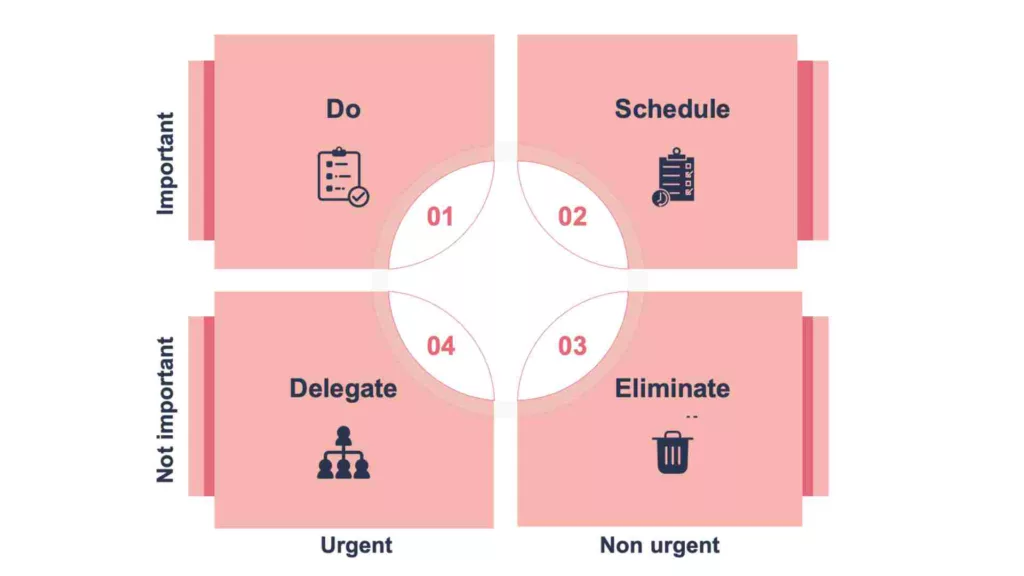
Creating the Eisenhower Matrix
Sketching the Framework
Draw a large square, dividing it into four equal sections.
Label the top row: “Urgent” (left) and “Not Urgent” (right).
Label the left column: “Important” (top) and “Not Important” (bottom).
Categorizing Your Ideas
- Quadrant I (Urgent & Important)
- Description: Ideas that require immediate attention due to time constraints or potential impact.
- Examples: Innovations that address a current market gap or capitalize on a time-sensitive opportunity.
- Quadrant II (Not Urgent & Important)
- Description: Strategic ideas that align with long-term goals but aren’t time-sensitive.
- Examples: Future product improvements or long-term market strategies.
- Quadrant III (Urgent & Not Important)
- Description: Ideas that seem immediate but may not contribute significantly to long-term objectives.
- Examples: Short-term marketing tactics that lack alignment with your brand’s vision.
- Quadrant IV (Not Urgent & Not Important)
- Description: Ideas that don’t necessarily align with your strategic goals or have an immediate demand.
- Examples: “Nice-to-have” features that neither differentiate your product nor cater to your primary audience.
Actioning Your Ideas
- Quadrant I: Dive into these ideas first or initiate pilot projects.
- Quadrant II: Allocate time for research and development, ensuring they’re part of your future roadmap.
- Quadrant III: Consider delegating these to teams that can assess feasibility or merge them with other initiatives.
- Quadrant IV: Reevaluate these ideas. If they don’t align with your strategy or audience needs, consider shelving them.
Essential Tips
- Honest Assessment: Be candid about the true urgency and significance of each idea.
- Prioritize Quadrant II: Spend ample time here, as these ideas often lead to sustainable growth and differentiation.
- Regular Revisits: Your business environment and priorities evolve; ensure your idea categorization remains relevant.
The Eisenhower Matrix is more than just a visual tool. By consistently applying this matrix, you can gain clearer insights into which ideas hold the most promise, ensuring strategic alignment and proactive decision-making.
8. Ivy Lee Method
The Ivy Lee Method is a simple and effective time management technique designed to boost productivity. Its roots go back to the early 20th century when it was introduced to Charles M. Schwab, the president of Bethlehem Steel Corporation, by Ivy Lee, a well-known productivity consultant of his time.
Here’s a modified version of the Ivy Lee Method that I’ve adapted for idea prioritization.
Ivy Lee Method for Idea Prioritization and Building an Innovation Runway
Steps of the Adapted Ivy Lee Method
- List Ideas: At the end of a brainstorming session or work week, write down six (and only six) of the most compelling ideas that have surfaced. These ideas should be noted based on their potential impact and feasibility.
- Prioritize: Review the list, and rank the ideas in order of their true potential for innovation and alignment with organizational goals. Stick to six ideas to ensure focus and clarity.
- Dive Deep into the First Idea: Begin by thoroughly exploring the first idea on your list. This might involve conducting a feasibility study, discussing it with a small team, or creating a prototype. Refrain from jumping between ideas.
- Progress Sequentially: Once you’ve sufficiently explored the first idea and set a direction for it (whether that’s to develop further, pivot, or abandon), move on to the next idea.
- Carry Over: If any ideas remain unexplored by the end of your set period (be it a week or a month), roll them onto the next period’s list.
- Refinement and Repeat: Consistently refine your approach, and repeat this process for each cycle of idea generation and exploration.
Building an Innovation Runway
- Feedback Loops: As you work through each idea, gather feedback. This iterative process ensures that as you move forward, you’re refining the idea based on real insights.
- Allocate Resources: Assign dedicated resources, whether that’s time, personnel, or budget, to ensure each prioritized idea gets the attention it deserves. This creates a runway, allowing your ideas to take off.
- Milestones: Set specific milestones for each idea. This can include stages like initial research, prototype development, testing, and final execution.
Benefits of the Adapted Ivy Lee Method
- Structured Innovation: By organizing and prioritizing ideas, you ensure the best ones get the attention they deserve.
- Forced Focus: Limiting the number of ideas forces a team to prioritize those with the highest potential, ensuring quality over quantity.
- Continuous Innovation Runway: The consistent approach of prioritizing and exploring ideas helps in maintaining a continuous pipeline of innovations.
- Clarity: With a clear direction for each idea, teams can channel their energies efficiently, leading to a more productive innovation process.
By utilizing the Ivy Lee Method for idea prioritization and building an innovation runway, you can create a systematic approach to innovation, ensuring you’re consistently working on ideas with the highest potential impact.
Summary
In product management and innovation, ensuring a smooth transition from big ideas to new products on your product roadmap can often seem like hard work. Thankfully, there are different frameworks that teams can employ to ease this prioritization process. These frameworks are not only effective prioritization techniques but also best practices that have been tested and trusted by the best product teams.
Comparing the Use Cases of Different Innovation Frameworks
The Idea Sorter, for instance, is a great way to allow team members to sift through a list of features, identifying those with the highest value for customer delight. For project managers having a hard time deciding the next step, the MoSCoW Method offers a prioritization method that categorizes product features based on business needs and the level of effort required. The KJ Method is particularly suited for a small group of people looking to understand the big picture, while the RICE Scoring Method (often just referred to as the “rice method”) provides a scoring system that weighs the potential value of innovative ideas against estimated effort.
With the Kano Model, product development teams can focus on enhancing the customer experience by determining which features bring the biggest impact. Conversely, the WSJF method is an innovative prioritization model that focuses on delivering the right features with less effort, ensuring that the most important work gets done first. The Eisenhower Box, a classic in effective prioritization, aids teams in distinguishing between urgent and important tasks, ensuring the highest priority items are the first things tackled.
Choose the Right Idea Prioritization Framework for Your Needs
Each framework or method, from the scoring models like RICE to the complexity model like WSJF, serves a different use case. Whether you’re a project manager or part of a sales team, choosing the right framework will depend on specific needs, such as aligning product decisions with company goals or gauging the level of impact versus effort.
Product ideas might be plentiful, but with limited time, it’s essential to have a good way to decide which ones transition from the to-do list to actual product strategy. It’s not just about picking a good idea or the right ideas, but about identifying which idea or project ideas hold the potential to be a big project or even a game-changer. Sometimes, what seems like a great idea might require high effort but offer low returns, making it essential to have an idea management system in place.
Translate Your Ideas into Meaningful Projects
In summary, while product prioritization might seem challenging, especially for new product teams with a myriad of innovative ideas, by employing different prioritization frameworks and understanding their different criteria, the decision-making process becomes less daunting. Ultimately, it’s about ensuring that the hard work of the team translates into products that meet the business’s needs and enhance the customer experience. This article has provided insights and best ideas on how to do just that. So, whether it’s a big project or new features for current projects, knowing how to prioritize is key. And with these methods, you’re well on your way.
Next Steps
Well done! You have selected and used your innovation framework to get a prioritized list of ideas. It’s time to screen your shortlisted ideas and validate them.
I have helpful articles on idea screening and idea validation. Just click on the buttons below to go straight to them.
